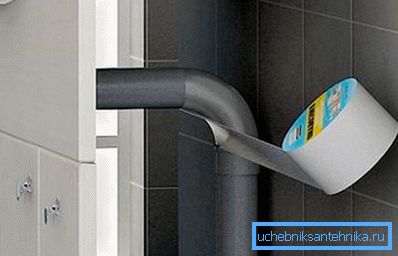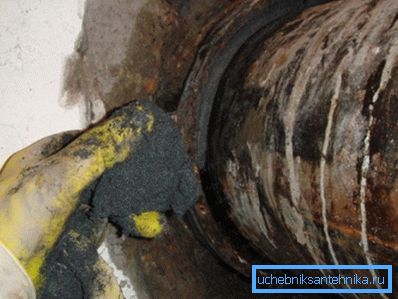Why do you need a sealant for sewage: how to choose and how
Since the sewage system is a system of series-connected pipes, it is quite natural that there is a certain risk of leakage at the joints of the elements.
Therefore, today manufacturers are trying to make their systems so that sealing of sewage pipes is either not needed at all or reduced to a minimum of actions.

It is worth noting that the factories are doing pretty well. However, completely do without additional isolation, still does not work out. Sealant for sewer pipes in most cases is definitely needed.
Without this substance, the connecting seam will not be as strong, and in addition the risk of leakage in these places in this case is quite high. And the blocking of unpleasant odors of sewage will be weak.
In this article we will look at how to choose such material and how to apply it in practice.
As illustrative examples, take the most popular sealants.
Most popular sealing methods

We note one important point. Protection of pipes that are embedded inside the wall should be carried out especially well, because the external highway in case of anything is not a problem to be repaired, and the line laid inside a brick or concrete cannot always even be disassembled so that the route remains intact. In addition, it is not easy to get to this type of sewage system, because you need to break up part of the wall, tiles, etc.
Therefore, in such a situation it is always better to be safe and make sure that the sealing of the sewage pipe joints is performed at the proper level.
Now let's look at how to do this.
With a special tape

This type of tape is a modern self-adhesive material with good anti-corrosion properties. Coils can be in the form of a conventional film and with the presence of foil coating.
The material has the following qualities:
- Simplicity and high speed of installation. After all, there is no need for any welding, soldering irons, etc. It is enough to wind the tape around the connection, and it will become airtight.
- The tape is quite resistant to accidental mechanical damage.. And this causes a long service life.
- The material does not conduct electricity through itself..
Note that with such qualities the price of the tape is acceptable for everyone.
As for the shortcomings, we can distinguish two problems:
- Lack of resistance to UV radiation. When operating in such conditions it is necessary to use a tape with a protective coating.
- A large number of low-quality fakes on the market. Try to buy products of famous brands with a good reputation.

And a brief instruction on the use of this material:
- We clean the plane of the pipe from debris, dust and grease stains. This can be done with an ordinary solvent.
- We are waiting until the working surface is completely dry.
- We begin to wind the tape onto the connecting ring of the line so that each turn of the film enters the other with an overlap of at least 50% of the total roll width. At the same time to wind the tape should be tight.
Please note that this sealant for PVC sewer pipes can be used not only for winding flat connections. The material is so flexible that you can safely use it to isolate turns, caps, etc.
Let us turn to the review of the following technology.
Silicone Sealing

Silicone is a rubber based substance. When interacting with open air, the material hardens and turns into a mass, which by its properties is similar to elastic rubber.
Sanitary sealant is not afraid of moisture and thanks to this quality it is used for sealing gaps, various cavities in bathrooms and kitchens. You can use it to handle connections in the sewer line. Moreover, this substance can reliably close up even the node sealing the inputs into the sewer well.
Tip: choose a silicone that is categorized as “neutral,” not “acidic.” The latter option, although inexpensive, but can dissolve upon contact with certain acids. And such quality is the risk of violation of the integrity of the connection.
The processing of PVC pipe joints with silicone is done by the following scheme:
- The inner and outer plane of the pipe is cleaned from dust and dirt.
- A special pistol is taken to extrude the silicone mass and with its help a thin layer of substance is applied to the surface of the inner circumference of the connecting ring of the pipe.
- The pipe is inserted into the adapter or other pipe.

- In this way, the whole highway is passed.
After the system is assembled and treated with sealant, it should be left stationary for about a day. During this time, the substance dries out and even with a slight shift of the elements the integrity of the joints will not be disturbed (due to the plasticity of the dried silicone).
As you can see the principle of "work" of the material is very simple.
Now let's take a look at other, less popular, but still reliable materials for sealing such compounds.
What other insulators are there?
It is best to consider everything in the comparative table.

| Material type | Application features |
| 1. Sulfur technical. | A distinctive feature of sulfur is its low cost. As a rule, it is treated with joints of cast-iron systems. The material is heated to the melting temperature and, as it were, poured into the inside of the slots. Applying sulfur effectively, but working with it is somewhat inconvenient. |
| 2. Bituminous mastic. | By its structure, the mastic resembles a molten resin, only after drying the first one is more plastic and not so fragile. Used for sealing cavities in ceramic or metal mains. |
| 3. Tow. | These are, in fact, thin fibers that are wound on the end of the pipes, and swell up under the influence of moisture and thereby block leaks. Can be used for systems of any material. For greater reliability, tow can be used in combination with silicone. |
| 4. Cement. | This substance is usually used in combination with asbestos and for sealing cast iron sewer lines. In the frozen state, the cement does not pass water. However, the use of cement is risky, because it may crack due to fluctuations or temperature fluctuations. |
| 5. Epoxy resin. | According to its properties, the material resembles durable glue. This type of resin is mainly used to seal cracks. For the treatment of standard compounds its use is impractical. Because, firstly, epoxy is expensive, and, secondly, it is much easier to work with the same silicone. |
So, than to seal sewer pipes now it is clear.

In general, it turns out that, in principle, all sealants are good, just that each has its own cost and is optimally suitable for processing the system from a particular material. And if you make a choice, relying on the last feature, then the chances of a leak will be really very low.
Conclusion
We have disassembled, than to seal the sewer pipe, as it can be done most simply and reliably. We hope that the provided tips will be useful to you in business, and you will be able to process the compounds as efficiently as possible. And if you want to learn more, then watch the video in this article.